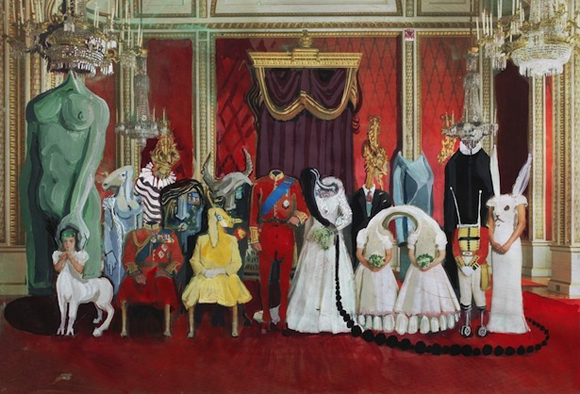5 October 2013–16 March 2014
An interview between Rokni Haerizadeh and Carnegie International Co-Curator Tina Kukielski
In his animation Just What Is It that Makes Today’s Homes So Different, So Appealing? Haerizadeh transforms found media imagery of protest, disaster, and violence from the 2009 Iranian demonstrations into fairy tales of sensual delights, where human heads of protestors and newscasters alike are replaced with those of animals. A more recent animation, Reign of Winter, debuting at the 2013 Carnegie International, takes on the subject of the British royal wedding.
Tina Kukielski: Your previous works, the portfolio of watercolor and gesso drawings that make up Fictionville (2009–ongoing) and the animation Just What Is It that Makes Today’s Homes So Different, So Appealing? (2010–11), made use of protest imagery from the news and other online media. Not coincidentally, you were working on these projects as the Arab Spring erupted. How did that affect the work?
Rokni Haerizadeh: I’ve been questioning the role of the spectator and his or her ethical stance as a consumer of media images for the past few years. Looking through the carnage of my accumulated archive of images, I began to detect the rhythm of a “system,” one that has turned us into numb spectators of violence. The theatrical display of violence in this system is seen everywhere, regardless of the location (Syria, Egypt, London) or the occasion (a wedding, a protest). Whether it be the coverage of uprisings around the world, a gathering of political leaders at a forum or a royal wedding, or a pop star’s funeral, the system is there wiping away one phenomenon with another.
We are consumers who, through viewing the repetitious images, indulge in a certain voyeuristic fulfillment as passive onlookers with a distorted (misplaced) moral gauge. We have become inured to the violence of our times.
The why and the how of this current “spectator” state of being interest me. I pervert the archived pictures, taking the images and the scenes away from the conventional moral codes.
Tina Kukielski: For your new animation, The Reign of Winter (2012–13), you chose to use imagery from the British royal wedding of Prince William and Kate Middleton. Why?
Rokni Haerizadeh: I’ve always been fascinated by rituals and their corresponding choreography of movements. And in my view, the arcane hysteria disguised within elaborate ceremonies asserts a system of dualities. A royal wedding is the ultimate manifestation of this: man and woman, old and new, poor and rich, nature and city, trees in a cathedral, car and carriage, royalty and commoners.
Tina Kukielski: When you were studying art in Iran, how important was the tradition of Persian miniatures to you as an artist? How did you choose the title for this work?
Rokni Haerizadeh: The poem “Reign of Winter” by Akhavan Sales, which often plays as a soundtrack to my thoughts, seemed to fit this project. It describes the bitter-cold cruelty of winter, and the colorless existence of those left outside at the mercy of the elements. There is a certain pathos in this poem, which captures the breath on the streets; it reflects the spirit of our times. Hossein Alizadehand later composed the music and the song is performed by Mohammed Reza Shajarian.
I carry within me the sensitivities of the culture I’ve grown up in, and so, yes, the relationship between literature and image in Persian paintings has had a strong influence on me and it’s something I explore in my works. In this project, I have brought language and image together again to watch them mate, wondering where they will lead me: from a poem to a soundtrack, which may then be reduced to a sound, or a noise, and perhaps ultimately lead to silence.
Tina Kukielski: Your work has been described as “ruthless criticism in the spirit of creative play.” Do you agree with this assessment?
Rokni Haerizadeh: I agree if:
“ruthless” is describing an unidentifiable state beyond morality or immorality—a power felt in an ocean wave or a bolt of lightning.
“creative” means free-flowing and unpredictable like the waves of a gem-filled ocean, always roaring.
“play” is a swing between comedy and tragedy—unruly, unyielding, playfully devoid of affirmation or condemnation. With no winners or losers. Shunning all mortal logic—eager to destruct. Always present.
In my view, art should provoke. It must employ cruelty, which is an inherent quality of life. If this cruelty is ignored, then art becomes just another manipulated plaything.
–Rokni Haerizadeh, interview with Tina Kukielski, 2013 Carnegie International, exh. cat. (Pittsburgh: Carnegie Museum of Art, 2013), 83–84.
Listen to Co-Curator Tina Kukielski reflect on Rokni Haerizadeh’s Work
Artists in Their Own Words – Rokni Haerizadeh
Preview of Reign of Winter Sketchbook
About Carnegie International
For more information contact info@ivde.net.
